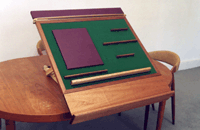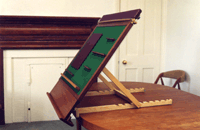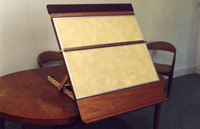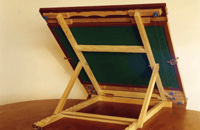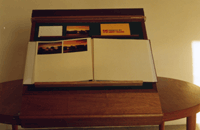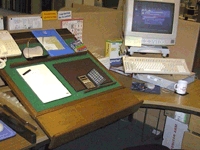Study Easel
UK Patent No: GB2340742[HOME]
Introduction
I developed the Study Easel to enable me to work comfortably at my desk without having to bend low over several items to read them. Individual devices (e.g.: bookstands) are obtainable to hold specific items but nothing was readily available to hold multiple and different objects. I had spent some time close checking numerical results on individual sheets of paper and at the same time had to consult large manuals. As a consequence gave myself some problems with my neck. So I needed something which could cope with both extremes. At the time I also had occasional need for a drawing board, so I made the work surface reversible to provide both.
Description
The main surface is a grid of holes, into which the various features are located by means of dowels fitting into these holes. Ledges of various sizes are used to support different sized objects (books, calculator, etc.) and smooth surfaces are attached for writing. Other devices can be fitted as required by providing them with similar dowels to locate in the holes. The lower part includes a fixed ledge to keep basic equipment (pens, pencils, etc.) to hand.
The main panel is reversible to provide the smooth surface of the drawing board. A parallel motion is provided and is stored on the upper fixed portion. Once the central panel is reversed the parallel motion can then be moved down for use.
Uses
This was originally designed for use in a technical office on the desktop (see pictures on the right). However it can be useful to anyone who needs to have several items at a comfortable angle. Researchers can have books or manuscripts supported alongside their written notes. An artist or designer who needs to have an original alongside their own creation to make both easier to see and use. Electronic assembly is also possible by having a circuit board supported on a ledge and the circuit diagram and manuals on other devices.
Patent
See the
Patent Document.
(Note that the address on the patent was where I was living at the time and not where I am now. I never got round to changing it for reasons below.)
I originally created the Study Easel in 1998 and it saw 18 months use on my office desk. I decided to see if I could get a patent for it, initially just as an academic exercise into what the process involved. Using information available from the Patent Office, and my experience as a technical writer, I wrote it myself. With the feedback from the P.O., plus a little professional input from a friend of a friend, I was ultimately successful: the patent being granted in early 2002. Patents can can be viewed via the esp@cenet website.
The Future
Shortly after submitting the patent I went to work abroad, and the patent was finally granted while out of the UK. This meant that I was not able to progress it further and it was put in the loft, where it still resides. My life has since moved on so it is unlikely to be progressed any further. However creating it and getting the patent were enjoyable challenges.
[HOME]
